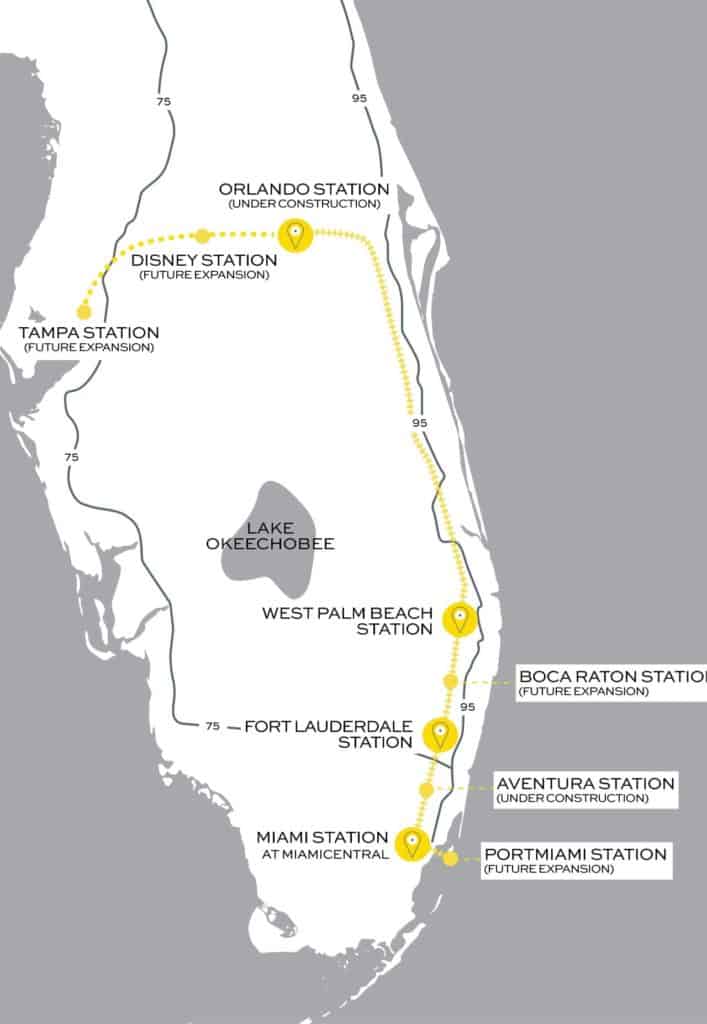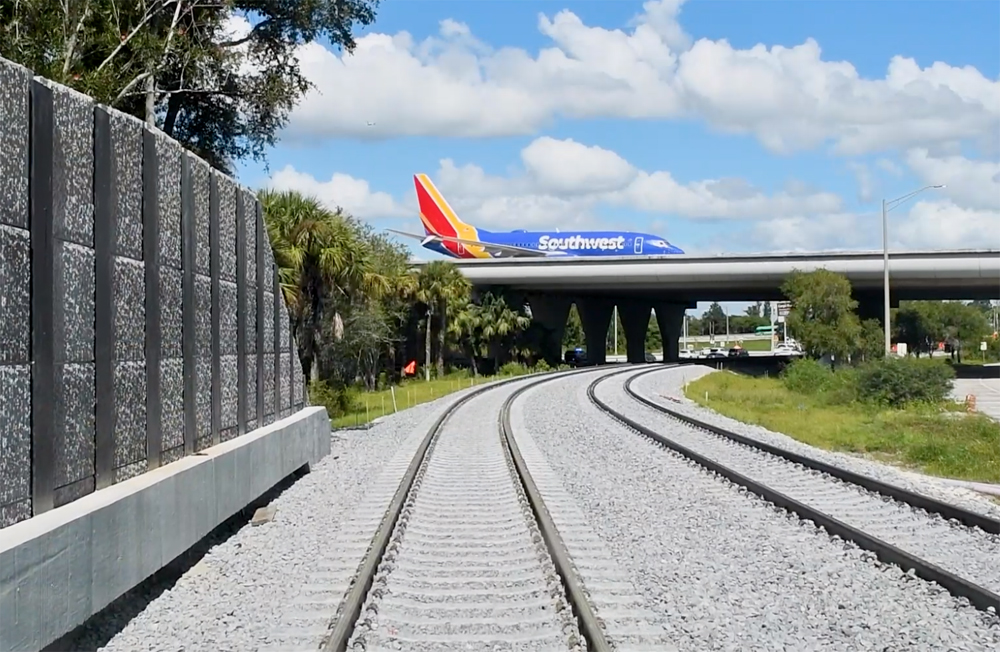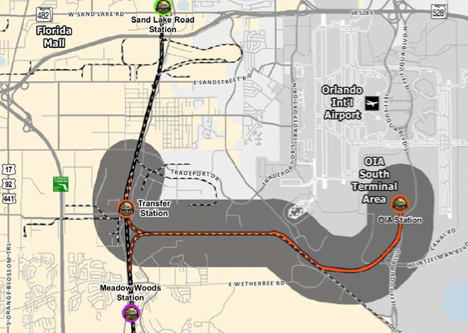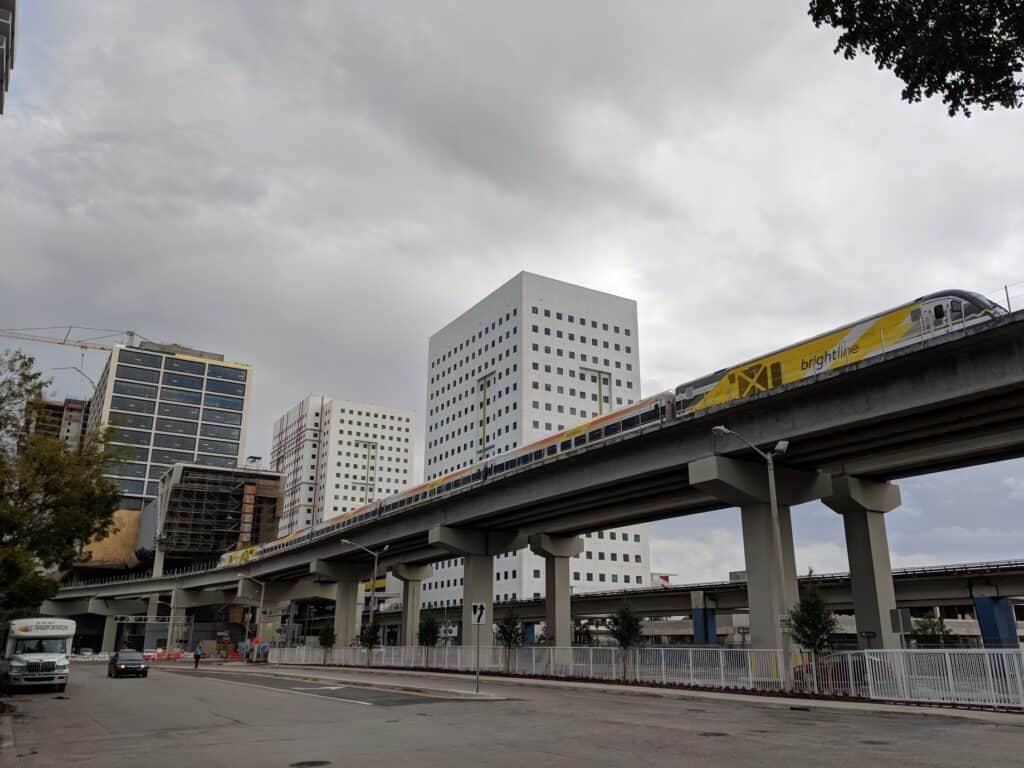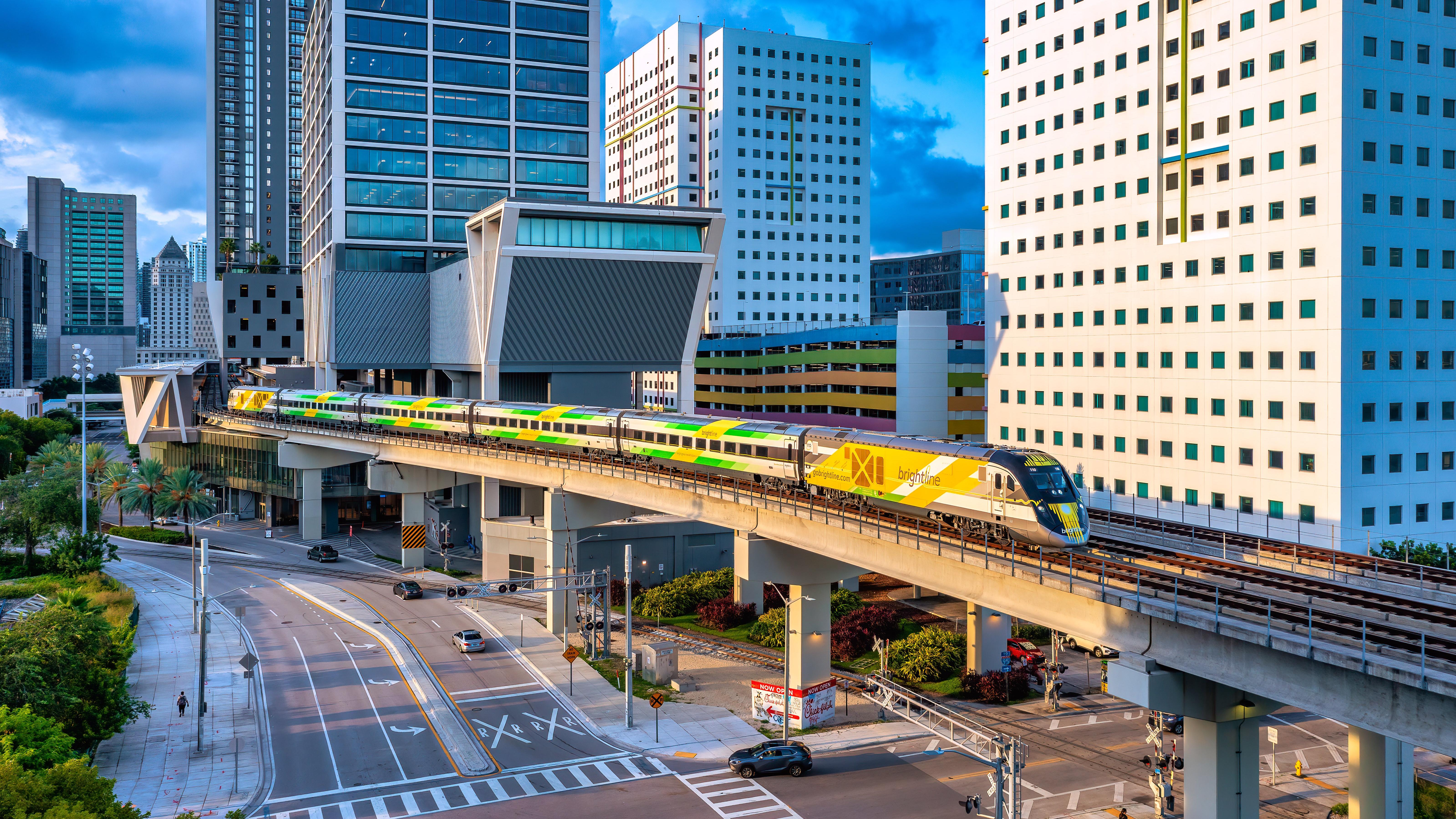bpiper
Well-Known Member
Interesting article in the Sentinel on an innovated construction technique used for the 3rd time in the USA but used widely elsewhere to minimize road closure time.
Brightline’s track construction pushes train tunnel under Orlando’s Goldenrod Road
By Kevin Spear
Orlando Sentinel |
Sep 17, 2020 at 5:17 AM
/cloudfront-us-east-1.images.arcpublishing.com/tronc/BMOCWCYQIRFQ5OACFSB2RJJO44.jpg)
Brightline jack-box tunnel installation
A worker checks out the excavation below Goldenroad Road in Orlando during the installation of a unique jack-driven box tunnel for the Brightline Trains route being built from Orlando International Airport to South Florida, Friday, September 11, 2020. The pre-cast, box-jack system is only the third of its kind used in the U.S. and reduces construction time from nearly a year to just a few weeks. (Joe Burbank/Orlando Sentinel) (Joe Burbank/Orlando Sentinel)
The multibillion-dollar job of building track from Orlando to South Florida for Brightline’s high-speed passenger rail has been earthshaking.
Or so it seemed in Orlando recently at one of the most unique and surprising construction works in the nation.
“You feel that? We are moving,” said Scott Gammon, Brightline’s senior vice president for construction. “We are riding 6,000 tons.”
He was standing in the middle of Goldenrod Road just south of the Beachline Expressway near the northeast corner of Orlando International Airport. Beneath his boots was a slab of concrete that was the top of a box being pushed into place by hydraulic jacks.
That box, to serve as a tunnel for a pair of Brightline tracks, is 272 feet long, 30 feet tall and 43 feet wide. It weighs 13,748,194 pounds, or nearly as much as 393,000 concrete blocks, which, if stacked on top of each other, would tower 49 miles high.
Concrete tunnels usually are big and heavy. What’s different about the one at Goldenrod is that it was built on a temporary construction yard. It was then slid, despite its mammoth heft, nearly the length of a football field to a permanent position a few feet beneath the road’s surface, all to significantly reduce construction time.

Workers watch the excavation below Goldenroad Road in Orlando during the installation of a unique jack-driven box tunnel for the Brightline Trains route being built from Orlando International Airport to South Florida, Friday, September 11, 2020. The pre-cast, box-jack system is only the third of its kind used in the U.S. and reduces construction time from nearly a year to just a few weeks. (Joe Burbank/Orlando Sentinel) (Joe Burbank/Orlando Sentinel)
The massive box nosed forward in eighth-inch pulses, reluctantly urged into motion by 20 jacks able to propel a combined 12,000 tons. Optimal cruising speed was 3 feet an hour.
An Italian firm, Petrucco, is directing what workers sometimes call “the push.”
“It’s not that technically advanced but it’s fairly novel,” Gammon said. “They’ve come up with a very clever way of doing this.”
With a deadline of late 2022, Brightline’s $2.7 billion, 170-mile extension from a train station at Orlando’s airport to a station in West Palm Beach is riddled with engineering and design puzzles.
Among them is how to get trains under Goldenrod next to where it connects with the tolled Beachline, and where it carries 16,000 vehicles a day as a feeder to the airport’s road network.
One construction bid proposed to build a conventional bridge for Goldenrod traffic, with clearance for trains beneath. That would bring detours and partial closures of Goldenrod for a year, Gammon said.
The other bid recommended closing Goldenrod entirely for two weeks. With the participation of Petrucco and a U.S. firm, Granite Construction, that bid and its "box jacking” approach won.

Steel spacing boxes are installked as work continues undernearth Goldenroad Road in Orlando on the installation of a unique jack-driven box tunnel for the Brightline Trains route being built from Orlando International Airport to South Florida, Friday, September 11, 2020. The pre-cast, box-jack system is only the third of its kind used in the U.S. and reduces construction time from nearly a year to just a few weeks. (Joe Burbank/Orlando Sentinel) (Joe Burbank/Orlando Sentinel)
“It’s something we are taking a lot of detailed notes on so that we can take this across the country,” said Richard Brown, Granite’s project manager for the Brightline job.
The concept of going underground for road, rail or pedestrians by pushing a prefabricated tunnel into place rather than boring and building a tunnel has previously been performed in various ways.
Petrucco has been perfecting its “box jacking services” since the late 1970s and now markets itself as the world’s expert, having completed more than 1,500 projects in Europe and the Middle East – but none in North America until recently.
“Humbly speaking, we are the leaders on this,” said Diego Rodriquez, Petrucco’s project manager for the Brightline job. “I think we are going to get really busy.”
The company recently installed a box tunnel for New York’s Long Island Rail Road and another in Vancouver, Canada. The third in North America is Brightline’s passage under Goldenrod Road.
“It’s simple but not easy,” said Rodriguez of the project, which has been running 24 hours a day and which he described as bigger than most due to its length.
Work started months ago, building the box – beginning with two halves – at the east side of Goldenrod Road on a large floor made of concrete and called a casting slab.
The halves were constructed with typical concrete walls embedded with steel-reinforcement bars: the bottoms are 3 feet thick and the sides and tops are 2 feet 7 inches thick.
The push began this month, with the hydraulic jacks shoving the first half into place and then the second half with the two pieces ultimately fused together with additional concrete.
Altogether, the tunnel encloses enough space to hold a half-dozen bungalow homes of downtown Orlando, as well as Brightline trains with two locomotives, 10 passenger cars and 15 feet tall.
The tunnel box is being installed in a section of Goldenroad Road where it rises upward – elevated on compacted fill dirt – to cross over the Beachline Expressway.
First, the asphalt and road underlayers of Goldenrod were dug up. Then, as the box was pushed into the side of Goldenrod’s elevated base, a pair backhoes got busy digging a trench immediately in front of the oncoming box.
Securing the hydraulic jacks was a feat. Their backstop is a vertical slab of concrete 5 feet thick and 20 feet tall, and mostly embedded in the ground. Immediately behind the slab is a 100-foot hill of dirt.
The box was steered left and right by adjustments to the force of the 20 hydraulic jacks, and up and down by the amount of soil in front of the box. Leaving more soil than normal would coax the box upward and removing more than normal would let it sink downward.
Brightline required the box to be within 6 inches of the designed path. “We are now within a few inches,” Gammon said.
Brightline’s deadline is for Goldenrod to be repaved and reopen by Tuesday.
The construction has been a rehearsal for a larger, more demanding repeat next year. Brightline must also get its train under the Beachline Expressway in Brevard County.
Unlike with Goldenrod Road, the Beachline can’t be closed entirely for any length of time. Constructed from three sections, the box there will be bigger than the one used for Goldenrod and it will be installed while traffic passes over.
kspear@orlandosentinel.com
Brightline’s track construction pushes train tunnel under Orlando’s Goldenrod Road
By Kevin Spear
Orlando Sentinel |
Sep 17, 2020 at 5:17 AM
/cloudfront-us-east-1.images.arcpublishing.com/tronc/BMOCWCYQIRFQ5OACFSB2RJJO44.jpg)
Brightline jack-box tunnel installation
A worker checks out the excavation below Goldenroad Road in Orlando during the installation of a unique jack-driven box tunnel for the Brightline Trains route being built from Orlando International Airport to South Florida, Friday, September 11, 2020. The pre-cast, box-jack system is only the third of its kind used in the U.S. and reduces construction time from nearly a year to just a few weeks. (Joe Burbank/Orlando Sentinel) (Joe Burbank/Orlando Sentinel)
The multibillion-dollar job of building track from Orlando to South Florida for Brightline’s high-speed passenger rail has been earthshaking.
Or so it seemed in Orlando recently at one of the most unique and surprising construction works in the nation.
“You feel that? We are moving,” said Scott Gammon, Brightline’s senior vice president for construction. “We are riding 6,000 tons.”
He was standing in the middle of Goldenrod Road just south of the Beachline Expressway near the northeast corner of Orlando International Airport. Beneath his boots was a slab of concrete that was the top of a box being pushed into place by hydraulic jacks.
That box, to serve as a tunnel for a pair of Brightline tracks, is 272 feet long, 30 feet tall and 43 feet wide. It weighs 13,748,194 pounds, or nearly as much as 393,000 concrete blocks, which, if stacked on top of each other, would tower 49 miles high.
Concrete tunnels usually are big and heavy. What’s different about the one at Goldenrod is that it was built on a temporary construction yard. It was then slid, despite its mammoth heft, nearly the length of a football field to a permanent position a few feet beneath the road’s surface, all to significantly reduce construction time.

Workers watch the excavation below Goldenroad Road in Orlando during the installation of a unique jack-driven box tunnel for the Brightline Trains route being built from Orlando International Airport to South Florida, Friday, September 11, 2020. The pre-cast, box-jack system is only the third of its kind used in the U.S. and reduces construction time from nearly a year to just a few weeks. (Joe Burbank/Orlando Sentinel) (Joe Burbank/Orlando Sentinel)
The massive box nosed forward in eighth-inch pulses, reluctantly urged into motion by 20 jacks able to propel a combined 12,000 tons. Optimal cruising speed was 3 feet an hour.
An Italian firm, Petrucco, is directing what workers sometimes call “the push.”
“It’s not that technically advanced but it’s fairly novel,” Gammon said. “They’ve come up with a very clever way of doing this.”
With a deadline of late 2022, Brightline’s $2.7 billion, 170-mile extension from a train station at Orlando’s airport to a station in West Palm Beach is riddled with engineering and design puzzles.
Among them is how to get trains under Goldenrod next to where it connects with the tolled Beachline, and where it carries 16,000 vehicles a day as a feeder to the airport’s road network.
One construction bid proposed to build a conventional bridge for Goldenrod traffic, with clearance for trains beneath. That would bring detours and partial closures of Goldenrod for a year, Gammon said.
The other bid recommended closing Goldenrod entirely for two weeks. With the participation of Petrucco and a U.S. firm, Granite Construction, that bid and its "box jacking” approach won.

Steel spacing boxes are installked as work continues undernearth Goldenroad Road in Orlando on the installation of a unique jack-driven box tunnel for the Brightline Trains route being built from Orlando International Airport to South Florida, Friday, September 11, 2020. The pre-cast, box-jack system is only the third of its kind used in the U.S. and reduces construction time from nearly a year to just a few weeks. (Joe Burbank/Orlando Sentinel) (Joe Burbank/Orlando Sentinel)
“It’s something we are taking a lot of detailed notes on so that we can take this across the country,” said Richard Brown, Granite’s project manager for the Brightline job.
The concept of going underground for road, rail or pedestrians by pushing a prefabricated tunnel into place rather than boring and building a tunnel has previously been performed in various ways.
Petrucco has been perfecting its “box jacking services” since the late 1970s and now markets itself as the world’s expert, having completed more than 1,500 projects in Europe and the Middle East – but none in North America until recently.
“Humbly speaking, we are the leaders on this,” said Diego Rodriquez, Petrucco’s project manager for the Brightline job. “I think we are going to get really busy.”
The company recently installed a box tunnel for New York’s Long Island Rail Road and another in Vancouver, Canada. The third in North America is Brightline’s passage under Goldenrod Road.
“It’s simple but not easy,” said Rodriguez of the project, which has been running 24 hours a day and which he described as bigger than most due to its length.
Work started months ago, building the box – beginning with two halves – at the east side of Goldenrod Road on a large floor made of concrete and called a casting slab.
The halves were constructed with typical concrete walls embedded with steel-reinforcement bars: the bottoms are 3 feet thick and the sides and tops are 2 feet 7 inches thick.
The push began this month, with the hydraulic jacks shoving the first half into place and then the second half with the two pieces ultimately fused together with additional concrete.
Altogether, the tunnel encloses enough space to hold a half-dozen bungalow homes of downtown Orlando, as well as Brightline trains with two locomotives, 10 passenger cars and 15 feet tall.
The tunnel box is being installed in a section of Goldenroad Road where it rises upward – elevated on compacted fill dirt – to cross over the Beachline Expressway.
First, the asphalt and road underlayers of Goldenrod were dug up. Then, as the box was pushed into the side of Goldenrod’s elevated base, a pair backhoes got busy digging a trench immediately in front of the oncoming box.
Securing the hydraulic jacks was a feat. Their backstop is a vertical slab of concrete 5 feet thick and 20 feet tall, and mostly embedded in the ground. Immediately behind the slab is a 100-foot hill of dirt.
The box was steered left and right by adjustments to the force of the 20 hydraulic jacks, and up and down by the amount of soil in front of the box. Leaving more soil than normal would coax the box upward and removing more than normal would let it sink downward.
Brightline required the box to be within 6 inches of the designed path. “We are now within a few inches,” Gammon said.
Brightline’s deadline is for Goldenrod to be repaved and reopen by Tuesday.
The construction has been a rehearsal for a larger, more demanding repeat next year. Brightline must also get its train under the Beachline Expressway in Brevard County.
Unlike with Goldenrod Road, the Beachline can’t be closed entirely for any length of time. Constructed from three sections, the box there will be bigger than the one used for Goldenrod and it will be installed while traffic passes over.
kspear@orlandosentinel.com

